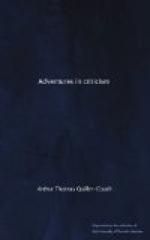“we can think of this or that, lightly or laughingly, as a child thinks, or as we think in a morning doze; we can make puns or puzzle out acrostics, and trifle in a thousand ways with words and rhymes; but when it comes to honest work, when we come to gather ourselves together for an effort, we may sound the trumpet as long and loud as we please; the great barons of the mind will not rally to the standard, but sit, each one at home, warming his hands over his own fire and brooding on his own private thought!”
Again, certain critics never seem tired of pelting the novelist with comparisons drawn between painting and photography. “Mr. So-and-So’s fidelity to life suggests the camera rather than the brush and palette”; and the implication is that Mr. So-and-So and the camera resemble each other in their tendency to reproduce irrelevant detail. The camera, it is assumed, repeats this irrelevant detail. The photographer does not select. But is this true? I have known many enthusiasts in photography whose enthusiasm I could not share. But I never knew one, even among amateurs, who wished to photograph everything he saw, from every possible point of view. Even the amateur selects—wrongly as a rule: still he selects. The mere act of setting up a camera in any particular spot implies a process of selection. And when the deed is done, the scenery has been libelled. Our eyes behold the photograph, and go through another process of selection. In short, whatever they look upon, men and women are selecting ceaselessly.
The artist therefore does well and consciously, and for a particular end, what every man or woman does poorly, and unconsciously, and casually. He differs in the photographer in that he has more licence to eliminate. When once the camera is set up, it’s owner’s power over the landscape has come to an end. The person who looks on the resultant photograph must go through the same process of choosing and rejecting that he would have gone through in contemplating the natural landscape. The sole advantage is that the point of view has been selected for him, and that he can enjoy it without fatigue in any place and at any time.




